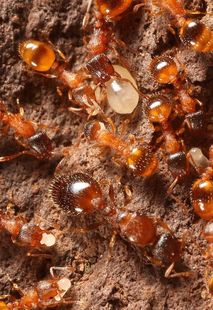AI: Ant Intelligence #445
October 27, 2017

This week we look at why ants seem to act much smarter in groups than on their own, and how we can study their swarm intelligence using robots. We'll be speaking with Stephen Pratt, associate professor in the School of Life Sciences at Arizona State University, about how ants in a colony work together to look for things they need, like nest sites and food. Then we'll speak with Simon Garnier, assistant professor in the Department of Biological Sciences at the New Jersey Institute of Technology, about ants that can make living structures out of their own bodies.
Guests:
- Stephen Pratt
- Simon Garnier
Guest Bios
Stephen Pratt
Stephen Pratt is an Associate Professor in the School of Life Sciences at Arizona State University. His research focuses on the emergence of complex social behavior in leaderless and decentralized animal groups, particularly social insects. He employs both theoretical and empirical approaches, and is also active in the development of bio-inspired algorithms for swarm robotics applications. He received a Ph.D. in neurobiology and behavior from Cornell University in 1997. Before coming to ASU, he worked as a postdoc at Harvard University, the Massachusetts Institute of Technology, Princeton University, and the University of Bath.
Simon Garnier
Simon Garnier is the head of the Swarmlab, an interdisciplinary research lab that studies why stupid creatures can - sometimes - be smart in groups, and why very smart beings will - often - form brainless crowds. In particular, he investigates how interactions between the different parts of a group can lead to extraordinarily efficient collective solutions, as well as snowballing catastrophes. This knowledge can then be used to solve complex problems such as the organization of traffic, the control of robotic swarms, and the functioning of large scale social networks.








